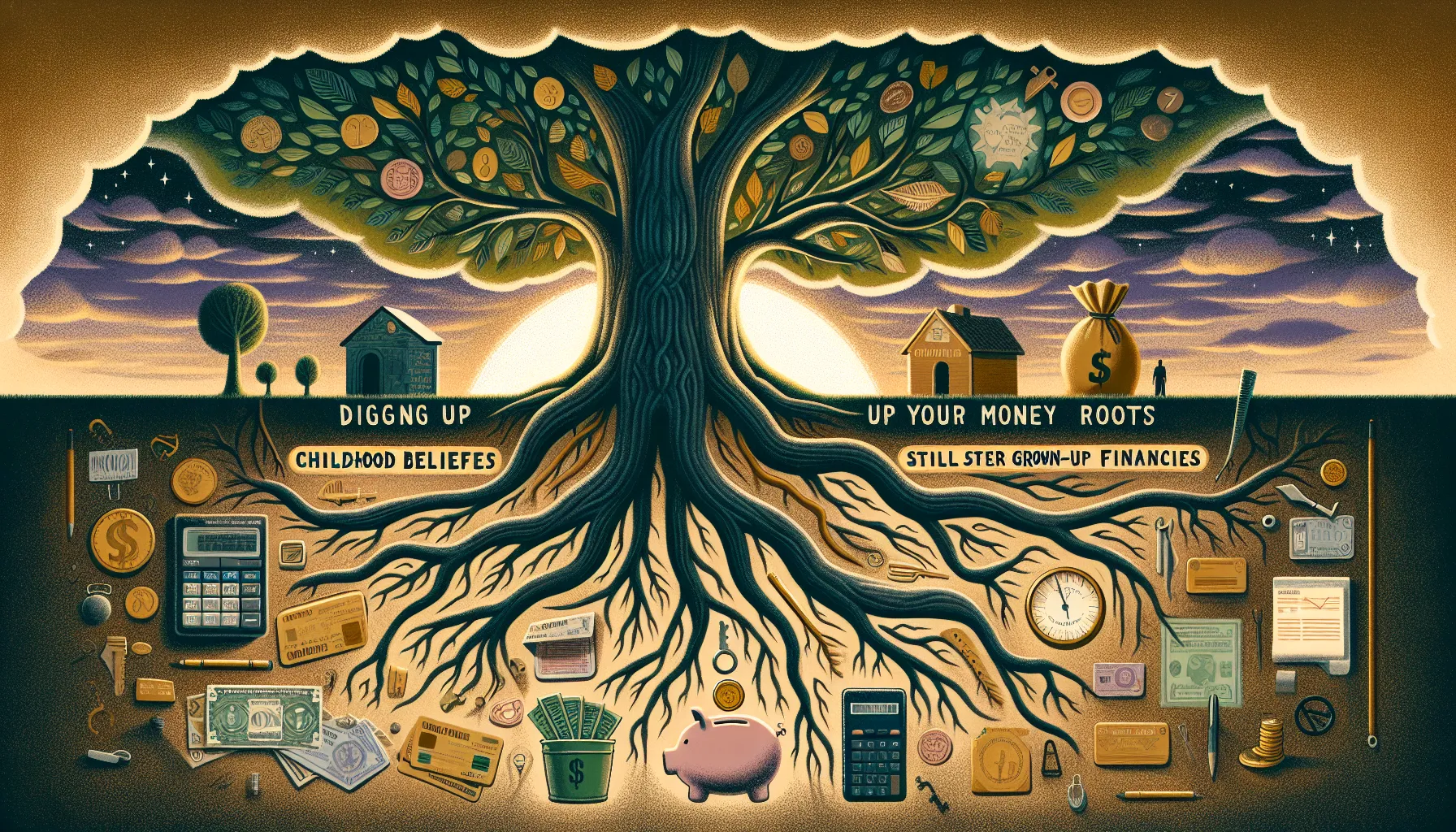Money isn't just math—it's psychology, memory, and even a bit of mystery. Years ago, my mentor had me try a hand-twirling illusion that looked simple but blew my mind. Funny how a finger pointing at the ceiling can teach you everything about why you might be stuck financially. Maybe a bit dramatic, but let's go with it: shifting your perspective, literally or figuratively, is the first domino in creating lasting financial freedom. If you’ve ever repeated money habits or felt anxiety every time you checked your bank balance, you’re definitely not alone. Today, we’ll walk through what’s really running the show in your head—and how you can bend the rules for good.
1. The Hand-Twirl Experiment: What a Shift in Perspective Really Means for Your Finances
Let’s start with a simple activity—a hand-twirl experiment that’s more powerful than it sounds. Imagine you’re sitting at your desk. Raise your right hand, point your index finger at the ceiling, and begin to trace a clockwise circle. Picture the motion: twelve, one, two, three, just like a clock. Now, slowly bend your elbow and bring your hand down so it’s below your eye level. Keep tracing the same circle. Suddenly, if you look down, the motion appears counterclockwise. Nothing changed except your perspective.
This quick experiment is a perfect metaphor for a Money Mindset shift. The facts—your hand’s motion—stay the same, but your viewpoint transforms the outcome. In finances, the same principle applies. Research shows that a Financial Mindset and Perspective Shift is foundational to building new money habits and achieving true financial success. It’s not always about the numbers or the logic; it’s about how you see and interpret your financial world.
Think about your own money story. Most people don’t realize that their financial direction can completely change just by looking at things differently. Maybe you grew up hearing, “Money doesn’t grow on trees,” or “We can’t afford that.” These early stories and beliefs act like invisible GPS coordinates, quietly steering your adult financial decisions. Studies indicate that childhood experiences and family scripts shape not only your attitudes about money but also your behaviors—often more than you realize.
Here’s where the hand-twirl comes in again. If you never question your viewpoint, you’ll keep tracing the same circle, over and over. But when you pause and shift your perspective, new possibilities appear—even if your financial facts haven’t changed. As one mentor put it,
All that's changed is your perspective. But with a change in perspective, it can lead to a profoundly different outcome.
Consider this: Most people approach their finances like trying to assemble IKEA furniture without instructions. They have all the pieces—income, expenses, savings, maybe some debt—but no clear guide or mindset to put it all together. It’s confusing, overwhelming, and often leads to frustration. A Mindset Shift is like finally getting the manual. Suddenly, the same pieces fit together in a way that makes sense.
Memory and perception influence your financial behavior far more than logic. You might know, rationally, that saving is important or that budgeting works. But if your underlying beliefs are rooted in scarcity or fear, your actions will reflect those hidden scripts. Research highlights that overcoming financial anxiety and building wealth starts with acknowledging these limiting beliefs and consciously choosing a new perspective—one that focuses on growth, opportunity, and long-term goals.
Reflect for a moment: Have you ever noticed your own spending or saving habits mirroring those of your parents or caregivers? That’s not coincidence. It’s the result of years of unexamined stories guiding your financial life. The good news? Just like the hand-twirl, you can choose to see things differently. And with that shift, you open the door to a new financial reality—one shaped by intention, awareness, and a healthy Financial Mindset.
 Scarcity Mindset: The Sneaky Saboteur Behind ‘Not Enough’ Thinking" />
Scarcity Mindset: The Sneaky Saboteur Behind ‘Not Enough’ Thinking" />2. Scarcity Mindset: The Sneaky Saboteur Behind ‘Not Enough’ Thinking
When you think about your relationship with money, it’s easy to assume your habits are shaped by logic or simple math. But research shows that the real driver is often something much deeper and harder to spot: your scarcity mindset. This mindset isn’t just about growing up with less—it can affect anyone, regardless of income or background. In fact, it’s so subtle that you might not even realize it’s influencing your daily choices.
Let’s start with what a scarcity mindset actually is. At its core, it’s the belief that there’s never enough—enough money, enough opportunity, enough security. This belief can quietly sabotage your financial goals, even if you’re aiming for abundance or generational wealth. As one expert puts it:
The hidden killer of financial dreams is a scarcity mindset.
With a scarcity mindset, you might find yourself making hasty, short-term decisions. Maybe you spend impulsively after a tough week at work because you feel you deserve it. Or perhaps you avoid investing in yourself, not because it’s a bad idea, but because deep down, you’re anxious about losing what little you have. These are common financial behaviors that often stem from limiting beliefs about money—like “money is the root of all evil” or “debt is always bad.”
Studies indicate that over 77% of Americans experience anxiety about money (FINRA study). Yet, only one in three Americans actually has a plan for their money. This gap highlights how financial anxiety strategies are often missing from our lives, even when we have access to financial tools and resources. The problem isn’t just a lack of information—it’s the powerful grip of old beliefs and subconscious habits.
Think back to your own upbringing. Did you see adults in your life struggle with bills or argue about spending? Maybe you learned to avoid talking about money altogether. These early experiences shape your financial mindset, and unless you challenge them, they can persist well into adulthood. In fact, research shows that childhood and upbringing significantly shape financial beliefs and behaviors, influencing how you relate to money as an adult.
It’s not just about what you learned, but also how those lessons became automatic. The scarcity mindset weaves itself into your logic and habits, making it hard to see opportunities for growth. It can make planning for the future feel risky or even impossible. That’s why many people—even those with high incomes—still feel stuck in a cycle of worry and short-term thinking.
Personally, I’ve noticed this in my own life. There were times I hesitated to invest in myself or my business, not because it didn’t make sense, but because of old anxieties from childhood. It wasn’t until I recognized these limiting beliefs about money that I could start shifting my mindset.
Overcoming a scarcity mindset isn’t about ignoring reality—it’s about acknowledging these beliefs and choosing a new perspective. Research suggests that a positive financial mindset involves moving from scarcity to abundance, focusing on opportunities and long-term growth. When you become aware of your own money story, you can start to rewrite it—and that’s where true financial success begins.

3. Digging Up Your Money Roots: Why Childhood Beliefs Still Steer Grown-Up Finances
Have you ever wondered why certain financial habits seem almost automatic, or why some money decisions trigger strong emotions? The answer often lies in your childhood beliefs about money. These early experiences shape your relationship with money well into adulthood, influencing your financial mindset and the choices you make—sometimes without you even realizing it.
Research shows that common financial behaviors are deeply rooted in subconscious beliefs formed during childhood. These beliefs can be positive, negative, or somewhere in between, but they all have an impact on your financial behavior as an adult. The first step to understanding your own financial mindset is to look back and take inventory.
Start with a Simple Self-Inventory
- Write down every childhood money memory—good, bad, or even neutral. Maybe you remember your parents arguing over bills, or perhaps you recall the excitement of saving up for a toy. Even memories that seem insignificant can reveal a lot about your underlying beliefs.
- Trace your emotional reactions to financial terms like “debt,” “saving,” “investing,” or “insurance.” Did your family treat these concepts as tools for growth, or as threats to be feared? Your current feelings about these terms often echo the attitudes you absorbed early on.
- Label your experiences as positive or negative. Take a look at your list—does it skew one way? Most people find that their memories lean negative, which is completely normal. This negative bias is common, but it’s also fixable. Awareness is the first step toward change.
As one expert puts it,
“A lot of the input on the big things of life, finances included, go straight into what becomes logic, belief, and habit for us as we grow.”These early scripts become the foundation for your adult financial behavior, often running in the background like invisible software.
The Subtle Power of Scarcity Mindset
One of the most persistent childhood beliefs about money is the scarcity mindset—the idea that there’s never enough. This belief can be subtle, weaving itself into your logic and habits, regardless of your actual level of wealth. Studies indicate that a scarcity mindset blocks clarity, peace, and direction, making it hard for your financial goals to thrive. If you grew up in an environment where money was a source of stress or secrecy, you might still avoid financial planning or feel anxious about spending and saving.
On the flip side, some people inherit more positive beliefs, seeing money as a tool for opportunity and growth. But even then, the patterns set in childhood can become outdated or unhelpful as you move through different stages of life. What helped you adapt as a child might hold you back as an adult.
Reflection: Connecting Money to Meaning
Sometimes, a personal turning point can shift your financial mindset for good. For example, one summer, you might realize your financial goals lack true meaning until you connect them to your family or a deeper purpose. This kind of reflection helps you move beyond inherited beliefs and create a financial vision that aligns with your values.
Ultimately, your financial behavior impact is not set in stone. By digging up your money roots and bringing subconscious beliefs to light, you can start to rewrite your story and build a healthier, more empowered financial mindset.
 Financial Legacy: From Numbers to Meaning" />
Financial Legacy: From Numbers to Meaning" />4. Building a Purpose-Driven Financial Legacy: From Numbers to Meaning
It’s easy to get caught up in the numbers when you think about financial success. Maybe you’ve set a goal to earn six figures, build seven streams of income, or stash away a certain amount in savings. These are common benchmarks in the world of wealth building strategies. But here’s the truth: numbers alone rarely keep you motivated for the long haul. If you stop at the numeric goal, you’re only scratching the surface of what’s possible with your financial vision purpose.
Research shows that long-term wealth building is most effective when you align your financial goals with your personal values and sense of purpose. It’s not just about the money—it’s about what that money can do for your life and the lives of those you care about. This is where creating financial vision becomes transformative. When you tie your goals to something meaningful, you unlock a deeper level of determination and consistency.
Let’s be honest: comparison and anxiety are constant threats on the journey to financial success. You might find yourself looking at what others are doing, wondering if you’re behind or missing out. But when you have a clear financial legacy purpose-driven goal, you stop measuring your progress against someone else’s story. Instead, your plan becomes anchored in what truly matters to you.
Everyone gets somewhere in life. A few people get there on purpose. Those are the ones with vision.
This quote from Andy Stanley captures the heart of the matter. Purpose is the difference between drifting and intentional living. It’s the glue that makes delayed gratification possible, turning fleeting discipline into a lasting legacy. When you can clearly articulate a purpose and a goal for your wealth and emotionally engage with what that means for you, now you have something meaningful and concrete that will hold you accountable, even when the instant gratification version of yourself doesn't feel like it.
For me, this shift became real the day I came home to my six-month-old son. His smile, his giggle—suddenly, my ‘why’ was staring me in the face. I realized that my financial decisions would shape not just my future, but his beliefs and habits too. My goals stopped being just about numbers. They became about time freedom, about being present for those moments that matter. That’s when strategies and solutions started to reveal themselves, almost naturally. The clarity and motivation I needed came from linking my money goals to a purpose far bigger than myself.
Studies indicate that creating a financial legacy means setting goals that reach beyond money to values and impact for future generations. It’s about building something that lasts, something that reflects who you are and what you stand for. So as you rethink your money story, don’t just chase the numbers. Dig deeper. Find your purpose. That’s where true financial success—and a meaningful legacy—begin.
TL;DR: Most financial anxiety isn’t really about dollars—it’s about perspective, old stories, and a few key mindset shifts. Question your beliefs about money and start designing your financial legacy with clarity and purpose.



